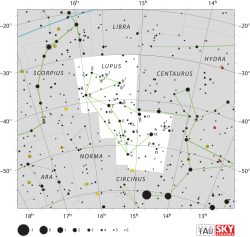おおかみ座ゼータ星
| おおかみ座ζ星[1] Zeta Lupi | ||
|---|---|---|
| 星座 | おおかみ座 | |
| 見かけの等級 (mv) | 3.41[1] | |
| 分類 | 連星 | |
| 位置 元期:J2000.0[1] | ||
| 赤経 (RA, α) | 15h 12m 17.09595s[1] | |
| 赤緯 (Dec, δ) | −52° 05′ 57.2919″[1] | |
| 赤方偏移 | -0.000033[1] | |
| 視線速度 (Rv) | -10.00 km/s[1] | |
| 固有運動 (μ) | 赤経: -112.92 ミリ秒/年[1] 赤緯: -71.18 ミリ秒/年[1] | |
| 年周視差 (π) | 27.80 ± 0.15ミリ秒[1] (誤差0.5%) | |
| 距離 | 117.3 ± 0.6 光年[注 1] (36 ± 0.2 パーセク[注 1]) | |
| 絶対等級 (MV) | 0.6[注 2] | |
ζ星の位置
| ||
| 物理的性質 | ||
| スペクトル分類 | G8III[1] | |
| 色指数 (B-V) | +0.92[2] | |
| 色指数 (U-B) | +0.66[2] | |
| 他のカタログでの名称 | ||
| CD-51 8830[1] CPD-51 7643[1] FK5 558[1] HD 134505[1] HIP 74395[1] HR 5649[1] SAO 242304[1] TYC 8306-3362-1[1] 2MASS J15121710-5205572[1] |
||
| ■Template (■ノート ■解説) ■Project | ||
おおかみ座ζ星(英語: Zeta Lupi)は、おおかみ座にある3等級の恒星である。
特徴
[編集]橙黄色の明るい主星と、黄色の暗い伴星から成るとされている[3]。視等級は3.41等級[1]。ヒッパルコス衛星による観測で得られた年周視差27.8ミリ秒から算出すると、地球との距離は約117.3光年となる[4]。
おおかみ座ζ星は連星であるとされており[5]、2013年の時点で、2つの恒星は離角71.20秒、位置角は68.8度だった[6]。主星は、スペクトル分類G8III型の巨星で、単体での視等級は3.5等級。主系列星の段階を終えて、レッドクランプの段階にあるとされる。角直径は2.55±0.13ミリ秒と測定されており[7]、これを基に計算すると、半径は太陽の約10倍となる[8]。
伴星単体での視等級は、6.74等とされている[6]。
| 指標 | 構成要素 | |
|---|---|---|
| 主星 | 伴星 | |
| スペクトル型 | ||
| 視等級 | 3.50 | 6.74[6] |
| 質量 (M☉) | 2.29 [9] | 1.15[10] |
| 半径 (R☉) | 10 [8] | 0.98[11] |
| 光度 (L☉) | 53 [12] | |
| 表面温度 (K) | 5,335 [12] | 6,351[13] |
| 表面重力 log g (cgs) | 3.01 [14] | |
| 金属量([Fe/H]) | 0.00 ± 0.02[14] | -0.03[13] |
脚注
[編集]注釈
[編集]出典
[編集]- ^ a b c d e f g h i j k l m n o p q r s t u “SIMBAD Astronomical Database”. Result for zet Lup. 2017年9月10日閲覧。
- ^ a b 輝星星表第5版
- ^ Streicher, M. (June 2007), “Lupus: a wild animal”, Monthly Notes of the Astronomical Society of South Africa 66 (5-6): 124−127, Bibcode: 2007MNSSA..66..124S
- ^ van Leeuwen, F. (2007), “Validation of the new Hipparcos reduction”, Astronomy and Astrophysics 474 (2): 653–664, arXiv:0708.1752, Bibcode: 2007A&A...474..653V, doi:10.1051/0004-6361:20078357
- ^ Eggleton, P. P.; Tokovinin, A. A. (September 2008), “A catalogue of multiplicity among bright stellar systems”, Monthly Notices of the Royal Astronomical Society 389 (2): 869–879, arXiv:0806.2878, Bibcode: 2008MNRAS.389..869E, doi:10.1111/j.1365-2966.2008.13596.x
- ^ a b c Mason, B. D.; Wycoff, G. L.; Hartkopf, W. I.; Douglass, G. G.; Worley, C. E. (2014), The Washington Visual Double Star Catalog, Bibcode: 2001AJ....122.3466M, doi:10.1086/323920 2017年9月10日閲覧。
- ^ Richichi, A.; Percheron, I.; Khristoforova, M. (February 2005), “CHARM2: An updated Catalog of High Angular Resolution Measurements”, Astronomy and Astrophysics 431: 773–777, Bibcode: 2005A&A...431..773R, doi:10.1051/0004-6361:20042039
- ^ a b Lang, Kenneth R. (2006), Astrophysical formulae, Astronomy and astrophysicslibrary, 1 (3rd ed.), Birkhäuser, ISBN 3-540-29692-1 半径(R☉)は以下の式から求める事が出来る。
- ^ Pizzolato, N.; Maggio, A.; Sciortino, S. (September 2000), Evolution of X-ray activity of 1-3 Msunlate-type stars in early post-main-sequence phasesjournal=Astronomy and Astrophysics, 361, pp. 614–628, Bibcode: 2000A&A...361..614P
- ^ Nordström, B.; et al. (2004-05), “The Geneva-Copenhagen survey of the Solar neighbourhood. Ages, metallicities, and kinematic properties of ˜14 000 F and G dwarfs”, Astronomy and Astrophysics 418: 989-1019, Bibcode: 2004A&A...418..989N, doi:10.1051/0004-6361:20035959
- ^ Pasinetti Fracassini, L. E.; et al. (2001-02), “Catalogue of Apparent Diameters and Absolute Radii of Stars (CADARS) - Third edition - Comments and statistics”, Astronomy and Astrophysics 367: 521-524, Bibcode: 2001A&A...367..521P, doi:10.1051/0004-6361:20000451
- ^ a b McDonald, I.; Zijlstra, A. A.; Boyer, M. L. (2012), “Fundamental Parameters and Infrared Excesses of Hipparcos Stars”, Monthly Notices of the Royal Astronomical Society 427 (1): 343–57, arXiv:1208.2037, Bibcode: 2012MNRAS.427..343M, doi:10.1111/j.1365-2966.2012.21873.x
- ^ a b Casagrande, L.; et al. (2011-06), “New constraints on the chemical evolution of the solar neighbourhood and Galactic disc(s). Improved astrophysical parameters for the Geneva-Copenhagen Survey”, Astronomy and Astrophysics 530: A138, Bibcode: 2011A&A...530A.138C, doi:10.1051/0004-6361/201016276
- ^ a b Soubiran, Caroline; Le Campion, Jean-François; Brouillet, Nathalie; Chemin, Laurent (June 2016), “The PASTEL catalogue: 2016 version”, Astronomy & Astrophysics 591: 7, arXiv:1605.07384, Bibcode: 2016A&A...591A.118S, doi:10.1051/0004-6361/201628497, A118

